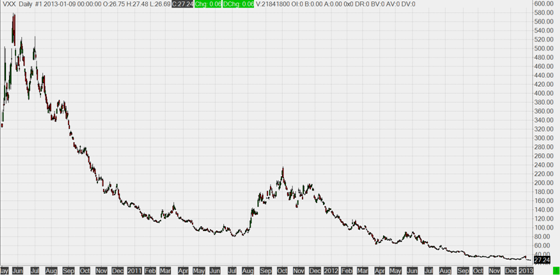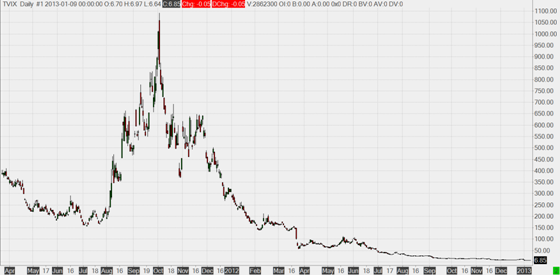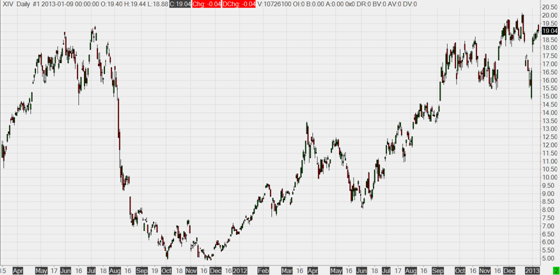With the growing media and public awareness of various volatility indices, derivatives, and exchange traded products (such as the VIX index or VXX ETN), many people wonder: Is volatility an asset class (like stocks, bonds, or commodities)?
Let's break this question down into three questions in order to answer it:
- Is volatility technically considered an asset class? Is it correct to speak of volatility as an asset class?
- Should volatility be added to a portfolio in the long run? Does it improve the risk/return characteristics (higher return, lower volatility, higher Sharpe ratio or whatever other measure you use)?
- Can volatility be profitably traded in the short run?
Is Volatility an Asset Class (Technically)?
What is an asset class? Different academics and investment professionals use different definitions of asset class and if you asked them to name asset classes, you would get different lists of things.
For example, Investopedia defines "asset class" as "a group of securities that exhibit similar characteristics, behave similarly in the marketplace, and are subject to the same laws and regulations".
The three traditional asset classes that almost everyone would list are the following:
- Equities (stocks)
- Fixed income (bonds and long-term interest rates)
- Cash and money market instruments
With the evolution of alternative investments and the change in what is considered asset management in the last decades, many people would also list some of the following asset classes:
- Commodities
- Real estate
- Private equity (venture capital, leveraged buyouts)
- Art, coins, and other collectibles
- Forex (currencies)
- Quantitative trading strategies
- Insurance
Many people would also consider hedge funds a standalone asset class, but when you look at the different hedge fund trading styles and strategies, you can see that the hedge fund asset class in fact contains something from all the other asset classes.
Furthermore, many people and institutions divide asset classes into sub-classes, such as large cap stocks vs. small cap stocks or domestic stocks vs. international stocks or developed vs. emerging markets.
The point is, there is no standardized or official list of asset classes. The purpose of dividing assets and investment instruments into asset classes is to not get lost in their growing universe and to organize big financial companies (a bank has an equities desk, a fixed income desk, a money market and forex desk etc.).
It does not really matter if you consider volatility an asset class or not. The only thing that matters is if you can improve your investment performance by adding volatility to your portfolio or by trading volatility in the short term.
Should Volatility Be Added to a Portfolio?
The real question asked when people ask about volatility being an asset class is whether it is good to add volatility to a portfolio (typically a long-only portfolio of stocks and bonds). This is a complex question and again, there is no universal answer. It always depends on:
- What are the other things you have in your portfolio?
- What is your time horizon?
- What is your desired return?
- What is your risk tolerance?
- And many other specifics like taxes or how often you want to check and adjust the portfolio.
I can't give you an answer for your particular case, but at least let me point out some risk and return characteristics of popular volatility exchange traded products. Below you can see the charts of VXX (long VIX), TVIX (2x long VIX), and XIV (short VIX).

In the long run VXX goes down. Being long volatility comes at a cost. It is logical when you consider volatility being a kind of insurance. The long volatility component of your portfolio will make money when stock market crashes (it will ease the pain a bit), but in the long run it will be a drag on your total performance.
In the long run, adding long volatility to a typical stock and bond portfolio results in:
- Lower return.
- Higher skewness.
By how much? Is it worth it? Should volatility be 2% or 5% or 10% of my portfolio?
These things depend on many factors, including how volatility is priced, which instruments you use, how you rebalance, and above all on the other components of your portfolio, their risk and return characteristics and mutual correlations. There are no simple answers.

If you add something like TVIX (2x long short-term VIX futures) to your portfolio, it will provide even greater increase in skewness and even greater long-term drag on return than the same amount of VXX.

Another idea might be to add a short volatility component to your portfolio. Theoretically it should have the opposite effect to long volatility, i.e. reduce skewness and increase long-term return (it would be like selling insurance). People have been doing these things since long before volatility ETNs were launched, typically by selling options. Many people got burnt.
Selling volatility is definitely something worth researching as one of the possible strategies, but its viability always depends on your particular circumstances and how volatility is priced at the moment. It must not be done blindly and solid risk management is necessary. Can you see how XIV went from 19.50 to 5 in 3 months on the chart above (and that was in 2011, far from the biggest spikes in volatility)? Do you think you can handle such move?
Can Volatility Be Traded Profitably?
In one word, yes (my own experience).
At the same time, you can also lose a lot of money trading volatility (my own experience too).
Volatility can be a very good market for short term trading because:
- It is volatile. Look at a chart of the VIX index or at the charts of the ETNs above on this page. They move a lot. The VIX is about 4-5x more volatile than the S&P500 on average; the front month VIX futures (that unlike the index are tradable) are a bit less volatile than the spot VIX, but still much more than S&P500 and most individual stocks.
- Liquidity used to be a problem, but it has been growing fast, at least on some of the securities: VIX futures, VIX options, VSTOXX derivatives in Europe, and some of the exchange traded products.
- It is stationary. With a stock, the fundamental value can go to zero at the bottom or to almost infinite at the top. Volatility also changes over time, but as long as the global financial markets work more or less in the same way as they do today, you can be quite sure that for example in the long run the VIX index will trade somewhere between 10 and 30-40, and occasional moves below 10 or above 40 will be reverted sooner or later.
- Many (though not all) market participants are in volatility markets to hedge their portfolios and not to generate alpha. They don't mind if they lose a little in volatility, as long as they improve the risk/return profile of their portfolios. They treat volatility markets as insurance markets.
- Many market participants have poor understanding of volatility and how it is priced. The return distributions are very specific here. Black-Scholes doesn't work. This is a chance for those who do understand volatility markets well (but don't be naive – there are some very smart people against you in volatility markets, as in any other markets).
- It's "macro". Unlike single stocks, there are no insiders, no need to follow and guess the actions of company management, and no risk of companies cooking their books.
Of course, it gets much more complicated than "buy VIX when it's low and wait till it gets high".